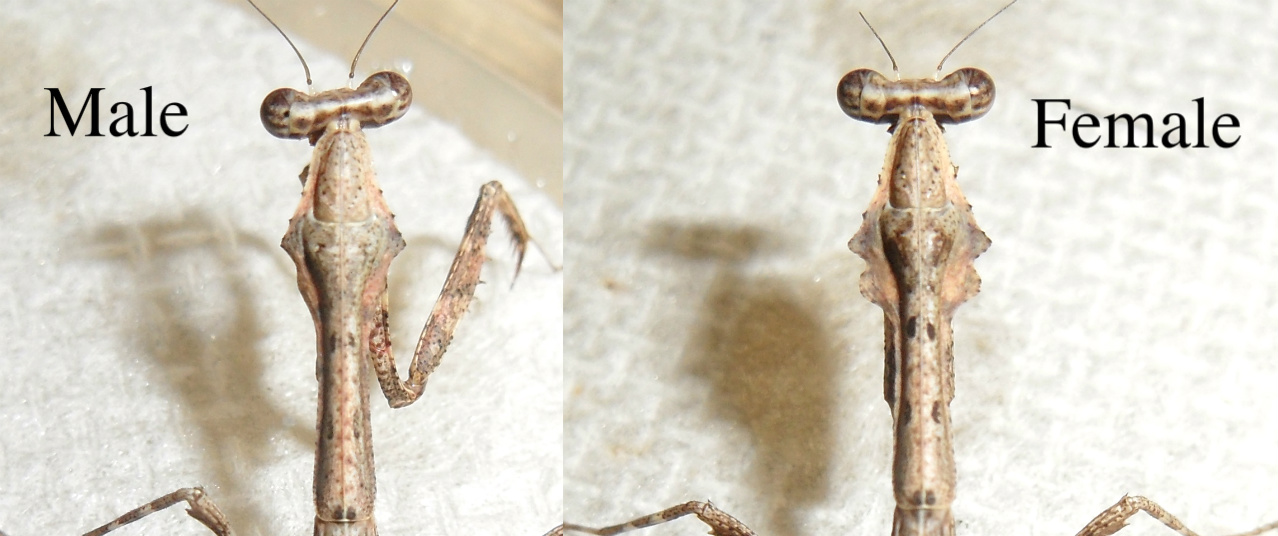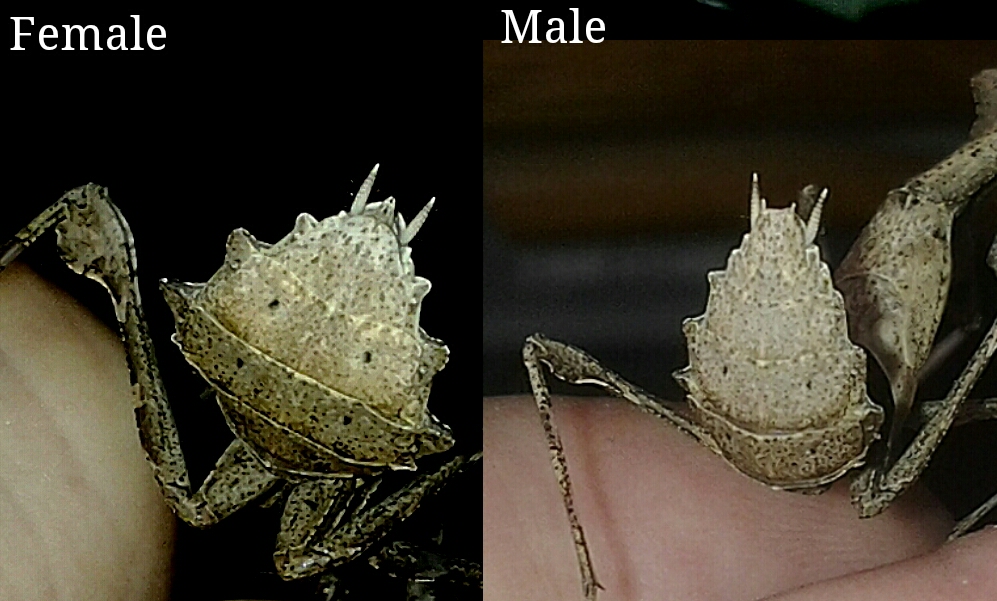You are using an out of date browser. It may not display this or other websites correctly.
You should upgrade or use an alternative browser.
You should upgrade or use an alternative browser.
Physical differences between male and female Deroplatys lobata reproductive organs
- Thread starter MantidBro
- Start date

Help Support Mantidforum:
This site may earn a commission from merchant affiliate
links, including eBay, Amazon, and others.
happy1892
Well-known member
Here is another way from L4 and up you probably can tell by the pronotum. But at L3 they seem to be the same. But you can look at the segments underside of the abdomen at L3 I think.


I saw that in google images, the differences in the pronotum, i tried using that method to sex mine but there wasnt as drastic a difference, they both have quite large "spikes". On the photo here the male's pronotum is smoother and smaller, on my male it looks very much like the female's. Ill take pictures later to show. Maybe ill catch something id missed once i do that too. I had guessed the sexes when they were at L4 but I wasnt positive til now, once they molted to L6. The photos i posted are actually my mantids, you can see clearly that one is male and one is female.Here is another way from L4 and up you probably can tell by the pronotum. But at L3 they seem to be the same. But you can look at the segments underside of the abdomen at L3 I think.

happy1892
Well-known member
Okay. As they grow older they would be different in pronotum shape in both females and males. But I thought at the same instar a female and male older than L4 or older would have different pronotum shape. Though maybe a male can skip a molt in D. lobata, I do not know. The above picture I posted is what I made, too. It is very easy to sex D. lobata by looking at the underside of the abdomen so the pronotum thing is not really needed.
I think my male may have one less molt, hes the same instar but his wings are much more pronounced. And as adults they have the same size wings, fhe males are only slightly longer, nothing drastic like with budwings. So his wings being twice as visible as hers is most likely an indication that hes going to reach adulthood before she does. Yeah i was surprised that at L4 I was able to guess their sex, by the segments, and turn out to be right. For other species ive owned it usually takes longer.Okay. As they grow older they would be different in pronotum shape in both females and males. But I thought at the same instar a female and male older than L4 or older would have different pronotum shape. Though maybe a male can skip a molt in D. lobata, I do not know. The above picture I posted is what I made, too. It is very easy to sex D. lobata by looking at the underside of the abdomen so the pronotum thing is not really needed.

$18.99 ($2.12 / Ounce)
Josh's Frogs Producing Wingless Drosophila Melanogaster Fruit Fly Culture
Josh's Frogs

$13.99 ($0.44 / Ounce)
Fresh Fruit Fly Culture (Drosophila Hydei) - Praying Mantis Mantid Frog Lizard Food - 32oz Cup
Surmen Legacy

$15.99
$19.99
RESTCLOUD Insect and Butterfly Habitat Cage Terrarium Pop-up 23.6 Inches Tall
Restcloud

$14.79 ($14.79 / Count)
Butterfly Breeding Net Folding Butterfly Habitat Cage White Butterfly Mesh Cage for Kid Garden Science Education Tool 40x40x60cm Butterfly Cage
Hubeichunliangnongyefazhanyouxiangongsi

$12.99 ($0.03 / Count)
Predator Foods Bulk Live Mealworms - 500 Count (Medium - 0.5")
Predator Foods

$16.14 ($16.14 / Count)
$16.99 ($16.99 / Count)
crapelles Spider Mantis Bottle Breathable Outdoor Natural Animal Exploration Tools Science Research Butterfly Frog Insect Colored Cage Habitat Bug Catcher Critter Caterpillars Cricket Snail Container
NANFANG YONGLIAN

$39.95 ($1.25 / Ounce)
Creation Cultivated 32oz Fruit Fly Culture - Live Feeder Insects for Praying Mantis, Jumping Spiders, Geckos, Lizards, Dart Frogs (Drosophila Hydei Flightless)
Creation Cultivated

$3.99 ($53.20 / lb)
$6.09 ($81.20 / lb)
Fluker's Gourmet Canned Food for Reptiles, Fish, Birds and Small Animals, Grass Hoppers 1.2 oz
Amazon.com

$18.50
Praying Mantis Egg Case With Hatching Habitat Cup- 2 Praying Mantids Egg Cases
NaturesGoodGuys

$13.99 ($13.99 / Ounce)
Surmen Legacy Freshly Started Flightless Drosophila Hydei Fruit Fly Culture
Surmen Legacy

$19.99 ($0.62 / Fl Oz)
byFormica Wingless Drosophila Melanogaster Fruit Fly Culture with ProGuard (Freshly Started, 32 oz. Cup (Excelsior))
byFormica Ant Products

$13.99 ($223.84 / lb)
Surmen Legacy Freshly Started Wingless Drosophila Melanogaster Fruit Fly Culture
Surmen Legacy
happy1892
Well-known member
Maybe you need a magnifying glass to help you see clearly the segments. I think so too about the male closer to adult than female because of much larger wing buds. And you counted each molt they had from L1?
Its not so much about not being able yo see, i realized on my t. Sinensis that by around L5, L6, if female, the last two segements merge and become one. Yes ive counted since i received them at L2 from aryia, she said they were at L2Maybe you need a magnifying glass to help you see clearly the segments. I think so too about the male closer to adult than female because of much larger wing buds. And you counted each molt they had from L1?


































